Integrating Field Data and Modeling for Sustainable Wastewater Irrigation Management: Case Studies from Jordan and Palestine
Abstract
1. Introduction
2. Materials and Methods
2.1. Study Area 1: Alfalfa in Jordan
2.2. Study Area 2: Citrus Palestine
2.3. SIM Model Setup
2.4. Sensitivity Analysis of Two FARMOD and ON-DEMAND Scenarios
2.5. Hypothetical Scenario for Alfalfa and Citrus
3. Results and Discussion
3.1. Case Study 1: Alfalfa in Jordan
3.1.1. Yield and Nutrient Efficiency for Alfalfa
3.1.2. Irrigation Management for Alfalfa
3.1.3. Nutrient Management for Alfalfa
3.1.4. Salinity and Escherichia coli Management for Alfalfa
3.2. Case Study 2: Citrus in Palestine
3.2.1. Yield and Nutrient Efficiency for Citrus
3.2.2. Irrigation Management for Citrus
3.2.3. Salinity Management for Citrus
3.2.4. Nutrients Management for Citrus
3.3. Sensitivity Analysis for Alfalfa and Citrus
3.4. Simulated Outcomes for Alfalfa and Citrus Hypothetical Scenario
4. Conclusions
Author Contributions
Funding
Data Availability Statement
Acknowledgments
Conflicts of Interest
References
- Ofori, S.; Abebrese, D.K.; Růžičková, I.; Wanner, J. Reuse of treated wastewater for crop irrigation: Water suitability, fertilization potential, and impact on selected soil physicochemical properties. Water 2024, 16, 484. [Google Scholar] [CrossRef]
- Liu, J.; Yang, H.; Gosling, S.N.; Kummu, M.; Flörke, M.; Pfister, S.; Hanasaki, N.; Wada, Y.; Zhang, X.; Zheng, C.; et al. Water scarcity assessments in the past, present, and future. Earths Future 2017, 5, 545–559. [Google Scholar] [CrossRef] [PubMed]
- Shemer, H.; Wald, S.; Semiat, R. Challenges and solutions for global water scarcity. Membranes 2023, 13, 612. [Google Scholar] [CrossRef]
- Qadir, M.; Sharma, B.R.; Bruggeman, A.; Choukrallah, R.; Karajeh, F. Non-conventional water resources and opportunities for water augmentation to achieve food security in water scarce countries. Agric. Water Manag. 2007, 87, 2–22. [Google Scholar] [CrossRef]
- Silva, J.A. Wastewater treatment and reuse for sustainable water resources management: A systematic literature review. Sustainability 2023, 15, 10940. [Google Scholar] [CrossRef]
- Dakkak, A. Water Scarcity in Jordan: An Overview. Available online: https://www.ecomena.org/water-jordan/ (accessed on 21 November 2024).
- Almanaseer, N.; Hindiyeh, M.; Al-Assaf, R. Hydrological and environmental impact of wastewater treatment and reuse on Zarqa river basin in Jordan. Environments 2020, 7, 14. [Google Scholar] [CrossRef]
- Ait-Mouheb, N.; Mayaux, P.L.; Mateo-Sagasta, J.; Hartani, T.; Molle, B. Water reuse: A resource for mediterranean agriculture. In Water Resources in the Mediterranean Region; Zribi, M., Brocca, L., Icamblay, Y., Molle, F., Eds.; Elsevier: Amsterdam, The Netherlands, 2020; pp. 107–136. [Google Scholar] [CrossRef]
- Jaramillo, M.F.; Restrepo, I. Wastewater reuse in agriculture: A review about its limitations and benefits. Sustainability 2017, 9, 1734. [Google Scholar] [CrossRef]
- Christou, A.; Agüera, A.; Bayona, J.M.; Cytryn, E.; Fotopoulos, V.; Lambropoulou, D.; Manaia, C.M.; Michael, C.; Revitt, M.; Schröder, P.; et al. The potential implications of reclaimed wastewater reuse for irrigation on the agricultural environment: The knowns and unknowns of the fate of antibiotics and antibiotic resistant bacteria and resistance genes—A review. Water Res. 2017, 123, 448–467. [Google Scholar] [CrossRef]
- Pedrero, F.; Kalavrouziotis, I.; Alarcón, J.J.; Koukoulakis, P.; Asano, T. Use of treated municipal wastewater in irrigated agriculture—Review of some practices in Spain and Greece. Agric. Water Manag. 2010, 97, 1233–1241. [Google Scholar] [CrossRef]
- Ghaitidak, D.M.; Yadav, K.D. Characteristics, and treatment of greywater—A review. Environ. Sci. Pollut. Res. 2013, 20, 2795–2809. [Google Scholar] [CrossRef]
- Isayenkov, S.V.; Maathuis, F.J.M. Plant salinity stress: Many unanswered questions remain. Front. Plant Sci. 2019, 10, 80. [Google Scholar] [CrossRef]
- Snapp, S.; Sapkota, T.B.; Chamberlin, J.; Cox, C.M.; Gameda, S.; Jat, M.L.; Marenya, P.; Mottaleb, K.A.; Negra, C.; Senthilkumar, K.; et al. Spatially differentiated nitrogen supply is key in a global food–fertilizer price crisis. Nat. Sustain. 2023, 6, 1268–1278. [Google Scholar] [CrossRef]
- Sdiri, W.; AlSalem, H.S.; Al-Goul, S.T.; Binkadem, M.S.; Ben Mansour, H. Assessing the effects of treated wastewater irrigation on soil physico-chemical properties. Sustainability 2023, 15, 5793. [Google Scholar] [CrossRef]
- Dragonetti, G.; Khadra, R. Assessing soil dynamics and improving long-standing irrigation management with treated wastewater: A case study on citrus trees in Palestine. Sustainability 2023, 15, 13518. [Google Scholar] [CrossRef]
- Lonigro, A.; Montemurro, N.; Rubino, P.; Vergine, P.; Pollice, A. Reuse of treated municipal wastewater for irrigation in Apulia region: The “IN.TE.R.R.A.” project. Environ. Eng. Manag. J. 2015, 14, 1665–1674. [Google Scholar] [CrossRef]
- Shelia, V.; Šimůnek, J.; Boote, K.; Hoogenbooom, G. Coupling DSSAT and HYDRUS 1-D for simulations of soil water dynamics in the soil-plant-atmosphere system. J. Hydrol. Hydromech. 2018, 66, 232–245. [Google Scholar] [CrossRef]
- Khadra, R.; Sagardoy, J.A.; Taha, S.; Lamaddalena, N. Participatory irrigation management and transfer: Setting the guiding principles for a sustaining monitoring & evaluation system—A focus on the mediterranean. Water Resour. Manag. 2017, 31, 4227–4238. [Google Scholar] [CrossRef]
- Mazahrih, N.T.; Albalawneh, A.; Bani Hani, N.; Khadra, R.; Abo Dalo, A.; Al-Omari, Y.; Alomari, B.; Abu Hammad, M.; Martin, I.; Fahd, K.; et al. Impact of reclaimed wastewater on alfalfa production under different irrigation methods. Water Pract. Technol. 2024, 19, 2226–2236. [Google Scholar] [CrossRef]
- American Public Health Association; American Water Works Association, W.E.F. Standard Methods for the Examination of Water and Wastewater, 24th ed.; APHA Press: Washington, DC, USA, 2023. [Google Scholar]
- Dragonetti, G.; Khadra, R.; Daccache, A.; Oubelkacem, A.; Choukrallah, R.; Lamaddalena, N. Development and application of a predictive model for treated wastewater irrigation management in a semiarid area. Integr. Environ. Assess. Manag. 2020, 16, 910–919. [Google Scholar] [CrossRef]
- Pichery, C. Sensitivity analysis. In Encyclopedia of Toxicology, 3rd ed.; Wexler, P., Ed.; Academic Press: Oxford, UK, 2014; pp. 236–237. ISBN 978-0-12-386455-0. [Google Scholar]
- Hamby, D.M. A review of techniques for parameter sensitivity analysis of environmental models. Environ. Monit. Assess. 1994, 32, 135–154. [Google Scholar] [CrossRef] [PubMed]
- Shin, M.-J.; Choi, Y.S. Sensitivity analysis to investigate the reliability of the grid-based rainfall-runoff model. Water 2018, 10, 1839. [Google Scholar] [CrossRef]
- Montazar, A.; Sadeghi, M. Effects of applied water and sprinkler irrigation uniformity on alfalfa growth and hay yield. Agric. Water Manag. 2008, 95, 1279–1287. [Google Scholar] [CrossRef]
- Lahlou, F.; Mackey, H.R.; McKay, G.; Onwusogh, U.; Al-Ansari, T. Water planning framework for alfalfa fields using treated wastewater fertigation in Qatar: An energy-water-food nexus approach. Comput. Chem. Eng. 2020, 141, 106999. [Google Scholar] [CrossRef]
- Hettiarachchi, H.; Ardakanian, R. Safe Use of Wastewater in Agriculture: Good Practice Examples; United Nations University, Institute for Integrated Management of Material Fluxes and Resources: Dresden, Germany, 2016; ISBN 978-3-944863-30-6. [Google Scholar]
- Assouline, S.; Russo, D.; Silber, A.; Or, D. Balancing water scarcity and quality for sustainable irrigated agriculture. Water Resour. Res. 2015, 51, 3419–3436. [Google Scholar] [CrossRef]
- Schneider, K.D.; Thiessen Martens, J.R.; Zvomuya, F.; Reid, D.K.; Fraser, T.D.; Lynch, D.H.; O’Halloran, I.P.; Wilson, H.F. Options for improved phosphorus cycling and use in agriculture at the field and regional scales. J. Environ. Qual. 2019, 48, 1247–1264. [Google Scholar] [CrossRef]
- Cordell, D.; Drangert, J.-O.; White, S. The story of phosphorus: Global food security and food for thought. Glob. Environ. Change 2009, 19, 292–305. [Google Scholar] [CrossRef]
- Li, J.; Wen, J. Effects of water managements on transport of E. coli in soil-plant system for drip irrigation applying secondary sewage effluent. Agric. Water Manag. 2016, 178, 12–20. [Google Scholar] [CrossRef]
- Estrada, I.B.; Aller, A.; Gomez, X.; Moran, A.; Garcia, A.I. The survival of Escherichia coli, faecal coliforms and Enterobacteriaceae in general in soil treated with sludge from wastewater treatment plants. Bioresour. Technol. 2004, 93, 191–198. [Google Scholar] [CrossRef]
- Malkawi, H.I.; Mohammad, M.J. Survival and accumulation of microorganisms in soils irrigated with secondary treated wastewater. J. Basic Microbiol. 2003, 43, 47–55. [Google Scholar] [CrossRef]
- Citrus, Food and Agriculture Organization of the United Nations. Available online: https://www.fao.org/land-water/databases-and-software/crop-information/citrus/es/ (accessed on 24 November 2024).
- Intrigliolo, F.; Intelisano, S. Effects of differential nitrogen application on nutrition, growth, yield, and fruit quality in young lemon trees. Acta Hort. 1997, 448, 499–507. [Google Scholar] [CrossRef]
- Khan, M.M.; Siddiqi, S.A.; Farooque, A.A.; Iqbal, Q.; Shahid, S.A.; Akram, M.T.; Rahman, S.; Al-Busaidi, W.; Khan, I. Towards sustainable application of wastewater in agriculture: A review on reusability and risk assessment. Agronomy 2022, 12, 1397. [Google Scholar] [CrossRef]
- Syvertsen, J.P.; Garcia-Sanchez, F. Multiple abiotic stresses occurring with salinity stress in citrus. Environ. Exp. Bot. 2014, 103, 128–137. [Google Scholar] [CrossRef]
- Russo, D.; Laufer, A.; Bardhan, G.; Levy, G.J. Salinity control in a clay soil beneath an orchard irrigated with treated wastewater in the presence of a high-water table: A numerical study. J. Hydrol. 2015, 531, 198–213. [Google Scholar] [CrossRef]
- García-Sánchez, F.; Syvertsen, J.P. Salinity tolerance of cleopatra mandarin and carrizo citrange citrus rootstock seedlings is affected by CO2 enrichment during growth. J. Am. Foc. Hortic. Sci. 2006, 131, 24–31. [Google Scholar] [CrossRef]
- Hammami, A.; Rezgui, S.; Hellali, R. Leaf nitrogen and potassium concentrations for optimum fruit production, quality and biomass tree growth in clementine mandarin under mediterranean climate. J. Hortic. For. 2010, 2, 161–170. [Google Scholar]
- Alva, A.K.; Paramasivam, S.; Fares, A.; Obreza, T.A.; Schumann, A.W. Nitrogen best management practice for citrus trees: II. Nitrogen fate, transport, and components of N budget. Sci. Hortic. 2006, 109, 223–233. [Google Scholar] [CrossRef]
- Morgan, K.T.; Obreza, T.A.; Kadyampakeni, D.; Hamido, S.; Ferrarezi, R.S.; Zekri, M. Nutrition of Florida citrus trees, 3rd edition: Chapter 9. Irrigation management to improve nutrient uptake: SL463 SS676, 2 2020. EDIS 2020, 65–70. [Google Scholar] [CrossRef]
- Jarvie, H.P.; Neal, C.; Withers, P.J. Sewage-effluent phosphorus: A greater risk to river eutrophication than agricultural phosphorus? Sci. Total Environ. 2006, 360, 246–253. [Google Scholar] [CrossRef]
- Zhang, X.-Y.; Trame, M.; Lesko, L.; Schmidt, S. Sobol sensitivity analysis: A tool to guide the development and evaluation of systems pharmacology models. CPT Pharmacomet. Syst. Pharmacol. 2015, 4, 69–79. [Google Scholar] [CrossRef] [PubMed]
- Wan, W.; Liu, Q.; Zhang, C.; Li, K.; Sun, Z.; Li, Y.; Li, H. Alfalfa growth and nitrogen fixation constraints in salt-affected soils are in part offset by increased nitrogen supply. Front. Plant Sci. 2023, 14. [Google Scholar] [CrossRef] [PubMed]
- Maas, E.V. Salinity and citriculture. Tree Physiol. 1993, 12, 195–216. [Google Scholar] [CrossRef] [PubMed]
- Kuntyastuti, H.; Lestari, S.A.D. Application of manure and npk fertilizer on grobogan variety and aochi/w-c-6-62 soybean as promise line in lowland vertisol ngawi, Indonesia. Nusant. Biosci. 2017, 9, 120–125. [Google Scholar] [CrossRef]
- Safari, G.H.; Yetilmezsoy, K.; Mahvi, A.H.; Zarrabi, M. Post-treatment of secondary wastewater treatment plant effluent using a two-stage fluidized bed bioreactor system. J. Environ. Health Sci. Eng. 2013, 11, 10. [Google Scholar] [CrossRef] [PubMed]
- Ayodele, F.; Babalola, T. Physico-chemical properties of an alfisol under different tillage systems in the basement complex of kogi state. Sci. Forum J. Pure Appl. Sci. 2021, 21, 286–290. [Google Scholar] [CrossRef]
- Chien, S.H.; Dzombak, D.A.; Vidic, R.D. Comprehensive evaluation of biological growth control by chlorine-based biocides in power plant cooling systems using tertiary effluent. Environ. Eng. Sci. 2013, 30, 324–332. [Google Scholar] [CrossRef]
- Legaz, F.; Primo-Millo, E.; Primo-Yufera, E.; Gil, C.; Rubio, J.L. Nitrogen fertilization in citrus. Plant Soil 1982, 66, 339–351. [Google Scholar] [CrossRef]
- Yang, M.; Long, Q.; Li, W.; Wang, Z.; He, X.; Wang, J.; Wang, X.; Xiong, H.; Guo, C.; Zhang, G.; et al. Mapping the environmental cost of a typical citrus-producing county in China: Hotspot and optimization. Sustainability 2020, 12, 1827. [Google Scholar] [CrossRef]
- Abi Saab, M.T.; Jomaa, I.; El Hage, R.; Skaf, S.; Fahed, S.; Rizk, Z.; Massaad, R.; Romanos, D.; Khairallah, Y.; Azzi, V.; et al. Are fresh water and reclaimed water safe for vegetable irrigation? empirical evidence from Lebanon. Water 2022, 14, 1437. [Google Scholar] [CrossRef]
- Wu, S.; Nishihara, M.; Kawasaki, Y.; Yokoyama, A.; Matsuura, K.; Koga, T.; Ueno, D.; Inoue, K.; Someya, T. Inactivation of Escherichia coli in soil by solarization. Soil Sci. Plant Nutr. 2009, 55, 258–263. [Google Scholar] [CrossRef]
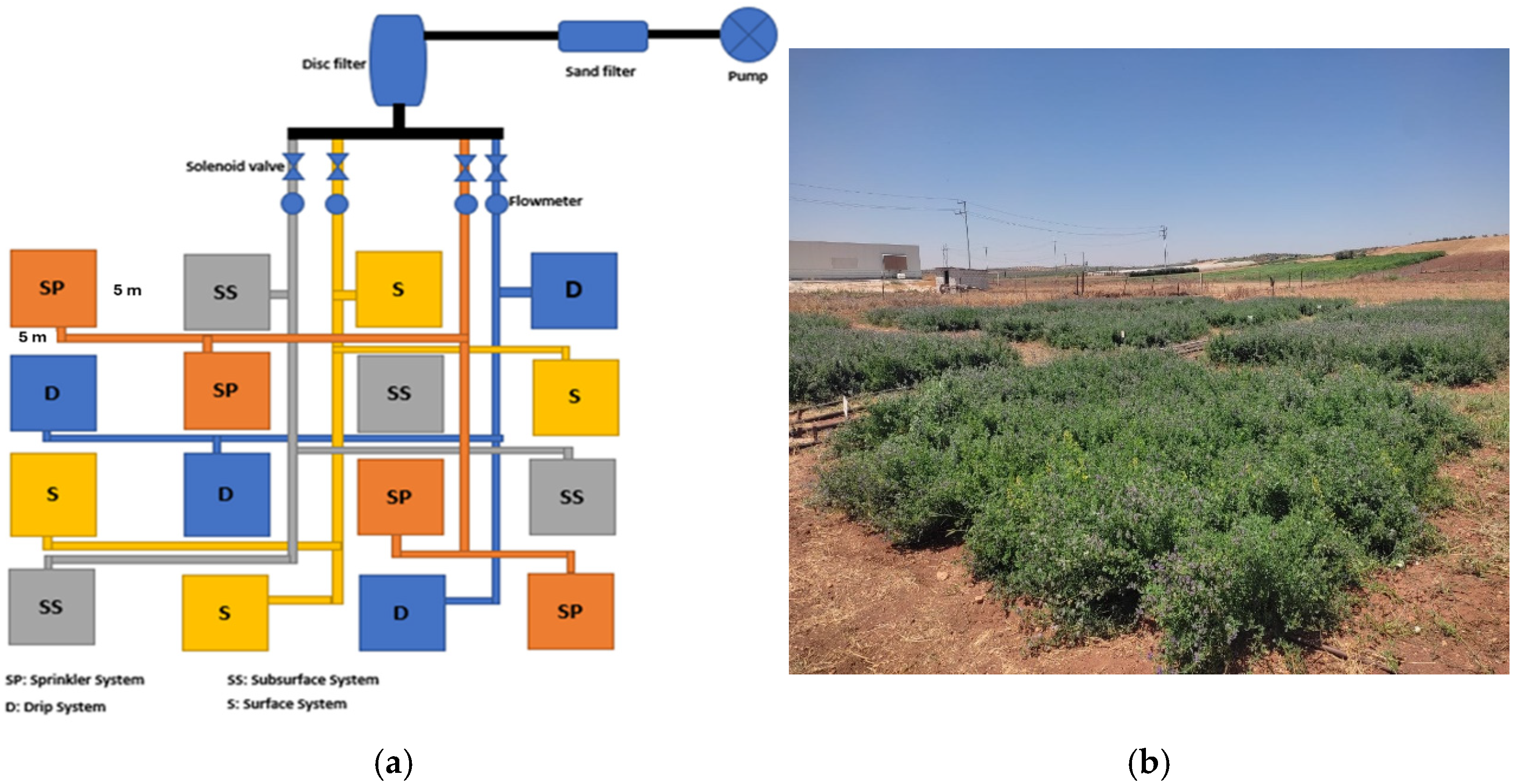
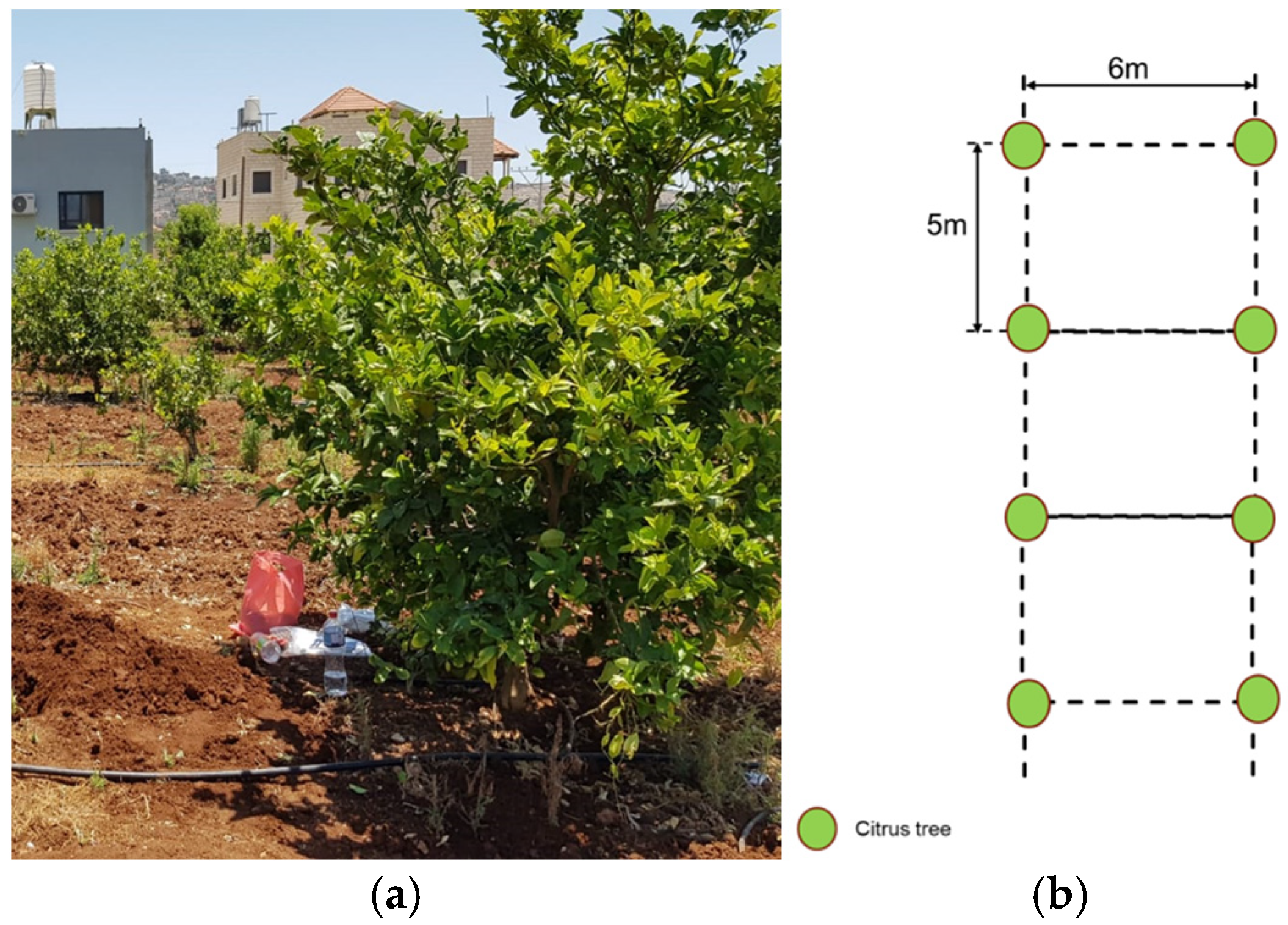
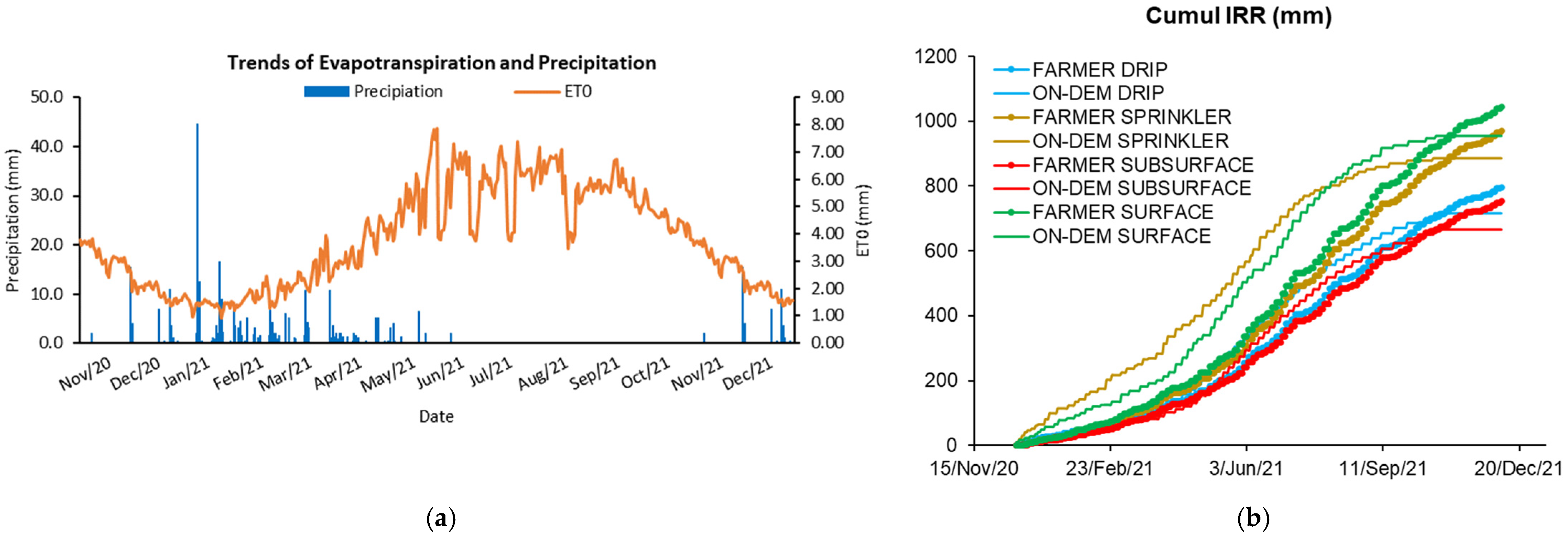



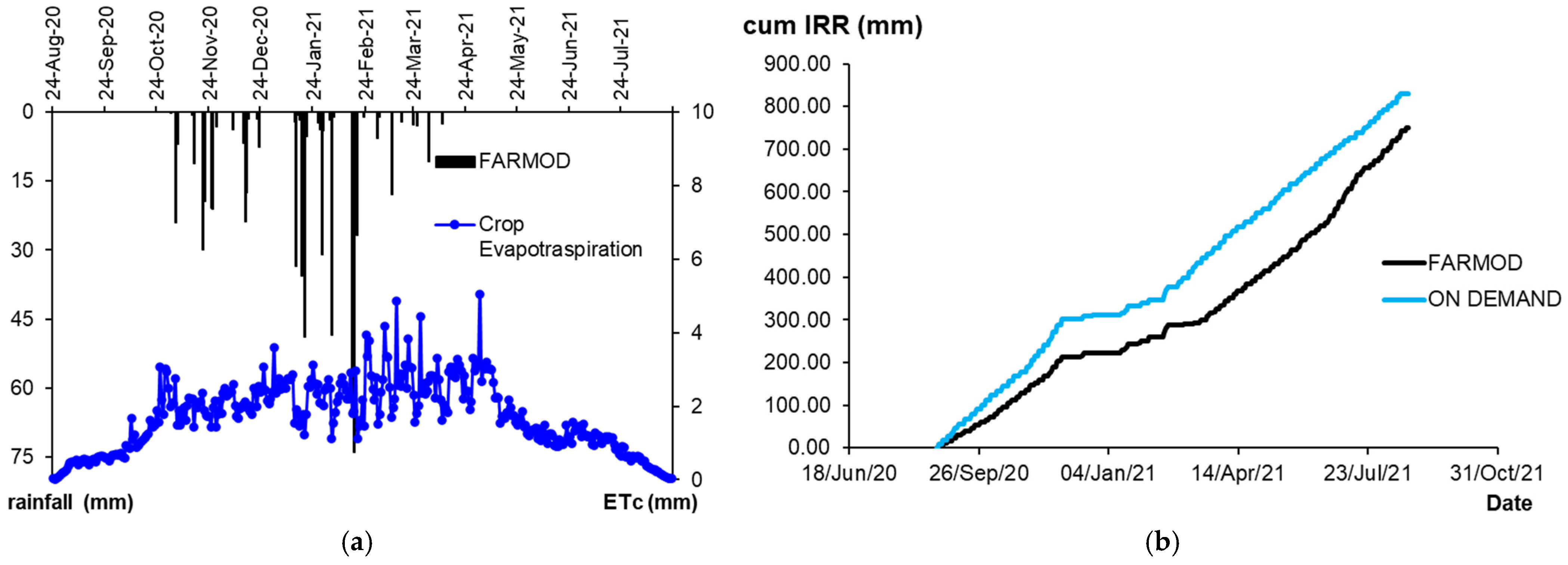
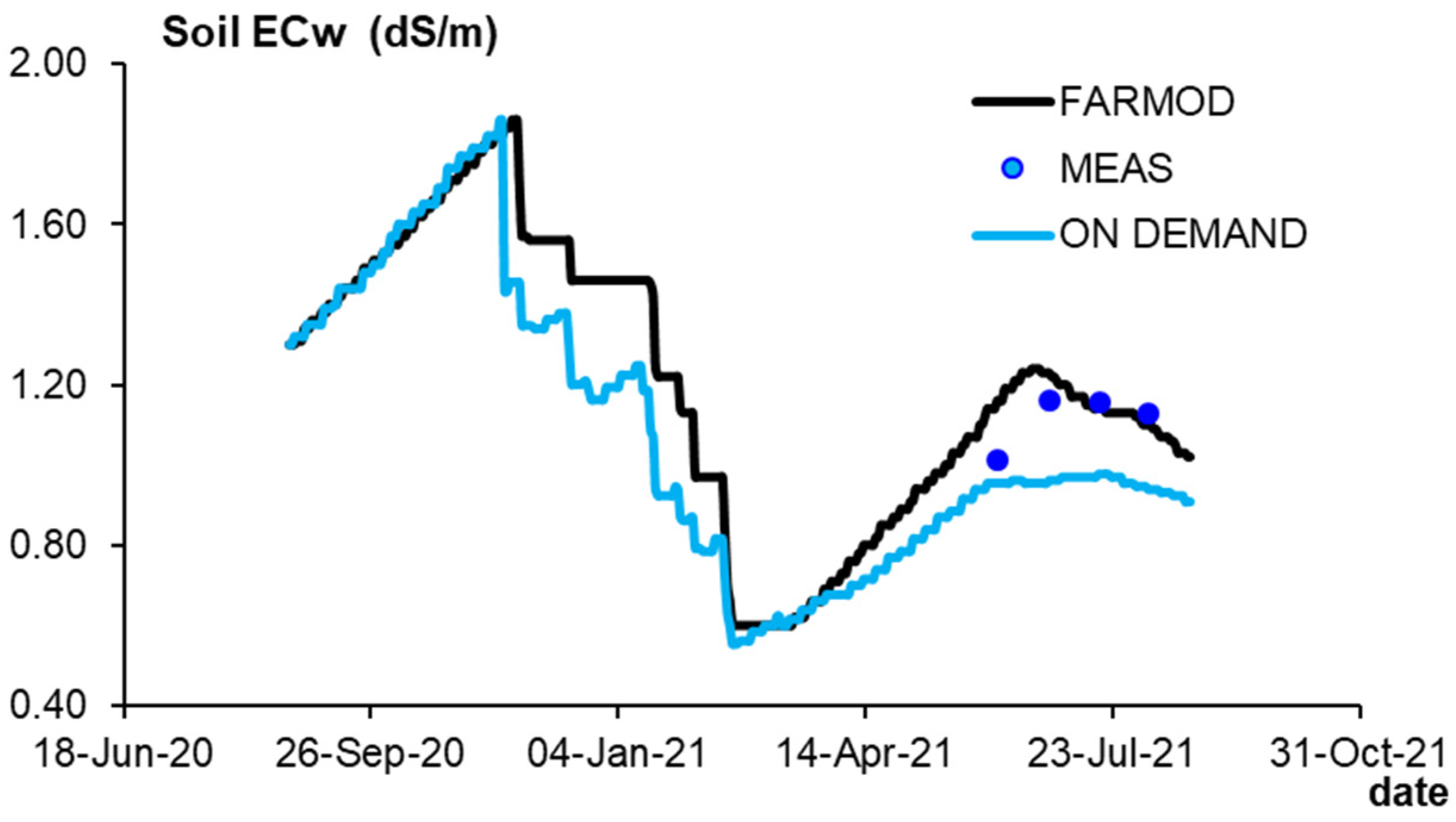

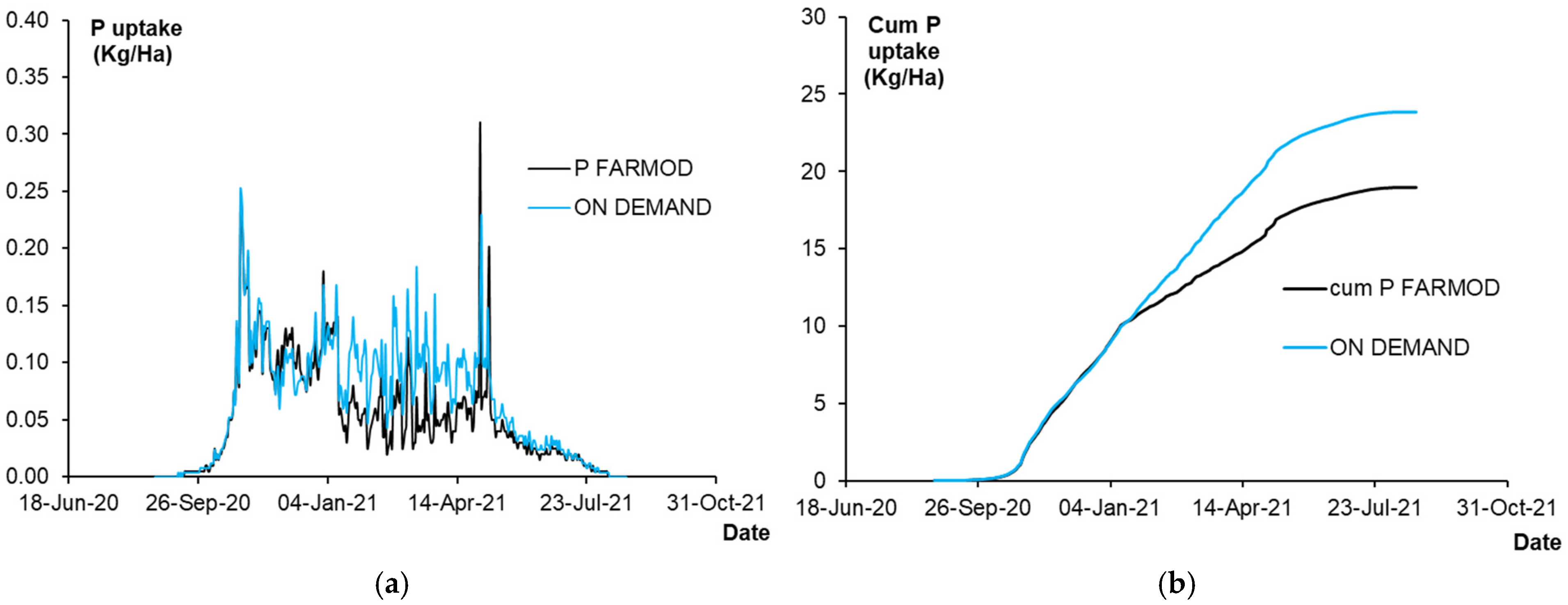

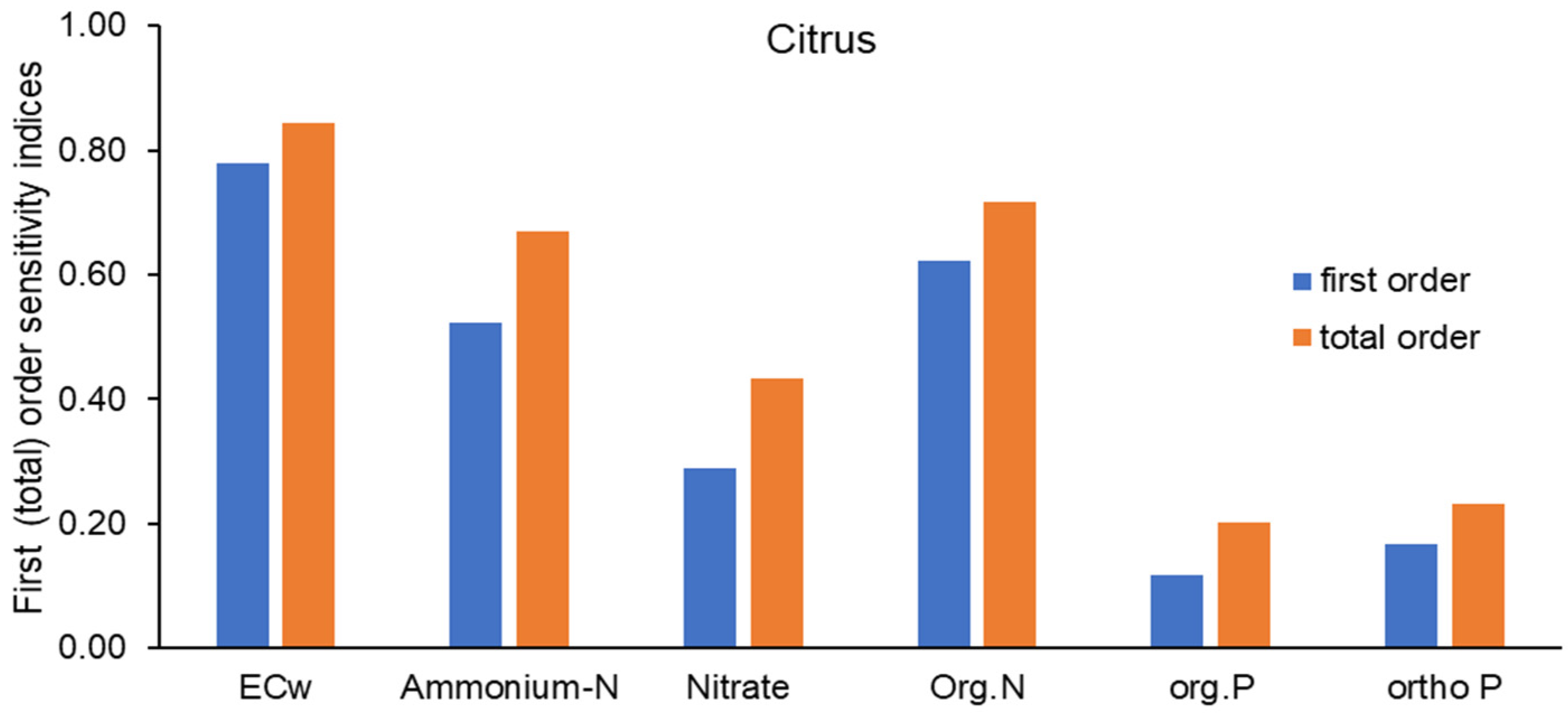
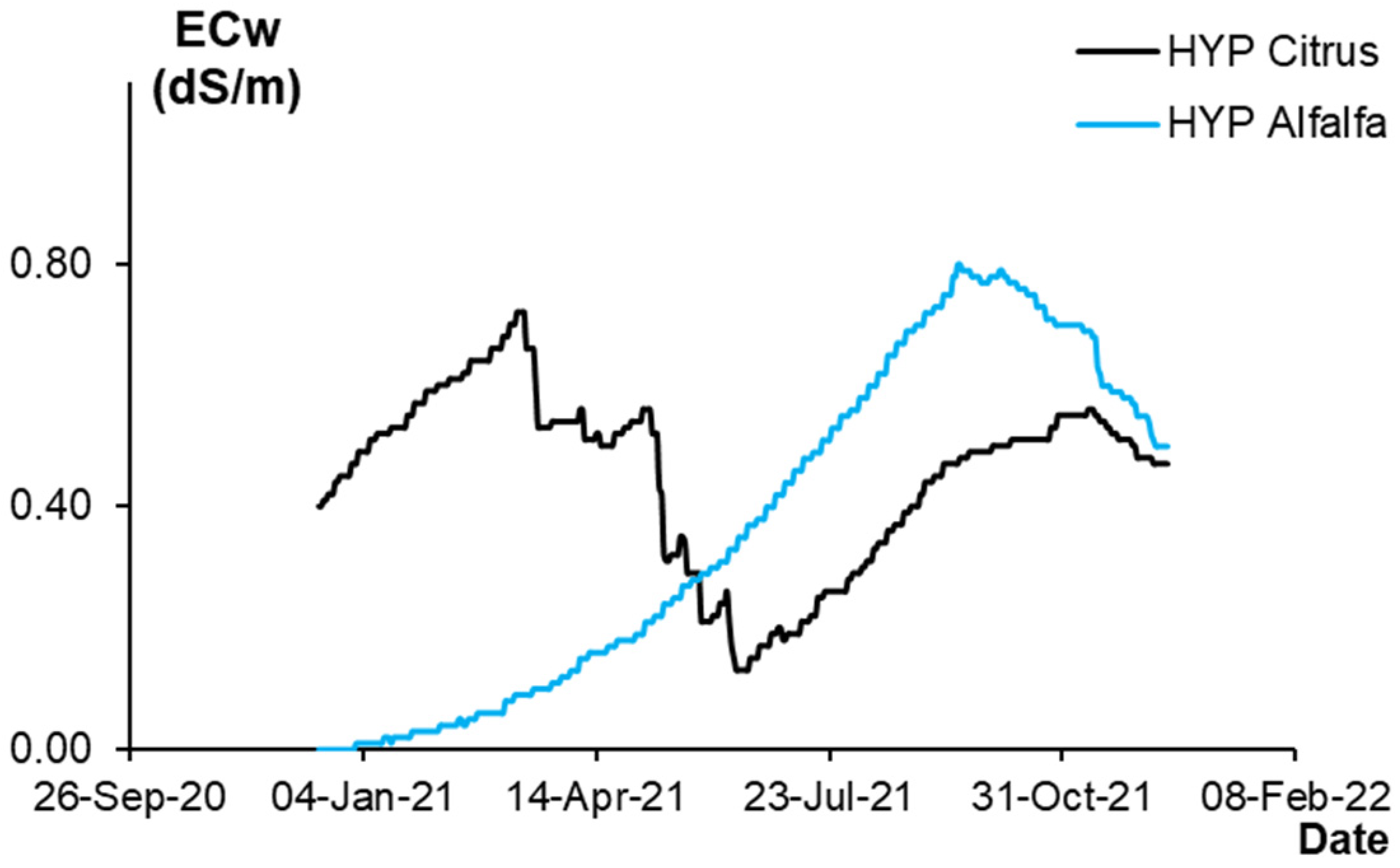


| FARMER | FARMOD | ON-DEMAND | |||||||
| Irrigation systems | Yield | N | P | Yield | N | P | Yield | N | P |
| Subsurface | 15,600 | 491 | 45 | 15,510 | 533 | 42 | 17,250 | 635 | 47 |
| Drip | 14,200 | 504 | 41 | 14,861 | 502 | 42 | 16,410 | 668 | 45 |
| Surface | 12,300 | 428 | 38 | 11,600 | 403 | 40 | 12,350 | 364 | 28 |
| Sprinkler | 9200 | 325 | 28 | 9980 | 380 | 32 | 11,650 | 445 | 33 |
| FARMER | FARMOD | ON-DEMAND | |||||||
|---|---|---|---|---|---|---|---|---|---|
| IRR system | Yield | N | P | Yield | N | P | Yield | N | P |
| Drip | 22,000 | 191.60 | 18.96 | 21,910 | 190.4 | 18.98 | 24,260 | 240.02 | 23.7 |
Disclaimer/Publisher’s Note: The statements, opinions and data contained in all publications are solely those of the individual author(s) and contributor(s) and not of MDPI and/or the editor(s). MDPI and/or the editor(s) disclaim responsibility for any injury to people or property resulting from any ideas, methods, instructions or products referred to in the content. |
© 2025 by the authors. Licensee MDPI, Basel, Switzerland. This article is an open access article distributed under the terms and conditions of the Creative Commons Attribution (CC BY) license (https://creativecommons.org/licenses/by/4.0/).
Share and Cite
Aziz, R.; Dragonetti, G.; Khadra, R. Integrating Field Data and Modeling for Sustainable Wastewater Irrigation Management: Case Studies from Jordan and Palestine. Water 2025, 17, 228. https://doi.org/10.3390/w17020228
Aziz R, Dragonetti G, Khadra R. Integrating Field Data and Modeling for Sustainable Wastewater Irrigation Management: Case Studies from Jordan and Palestine. Water. 2025; 17(2):228. https://doi.org/10.3390/w17020228
Chicago/Turabian StyleAziz, Rodolphe, Giovanna Dragonetti, and Roula Khadra. 2025. "Integrating Field Data and Modeling for Sustainable Wastewater Irrigation Management: Case Studies from Jordan and Palestine" Water 17, no. 2: 228. https://doi.org/10.3390/w17020228
APA StyleAziz, R., Dragonetti, G., & Khadra, R. (2025). Integrating Field Data and Modeling for Sustainable Wastewater Irrigation Management: Case Studies from Jordan and Palestine. Water, 17(2), 228. https://doi.org/10.3390/w17020228






